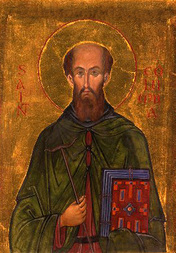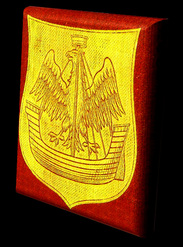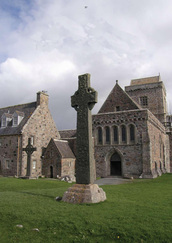"The island of Iona has a particular aesthetic, appearing to be on the edge of the known world and with open sky and seascapes, it feels elemental. This atmosphere has affected writers and artists from the late 6th century onwards." {Ms Doreen Grove, Head of Cultural Services and past Principal Inspector of Ancient Monuments; 2003.}
(From their own website) - Historic Scotland (HS) and the Iona Community together hosted a research workshop on April 10th to 13th 2012 which added considerably to the understanding of the island of Iona, the Abbey, the Nunnery and the collection of intricately carved stones.
The research conference has informed planning for events in 2013 marking the 1450th anniversary of St Columba’s departure from Ireland in 563 AD. It helped to refine a Draft Research Framework [pdf] and to obtain stakeholder views on Interim Statements of Cultural Significance for the Abbey [pdf] and for the Nunnery, St Ronan’s Church and Maclean’s Cross [pdf].
Click on the speakers name to access the presentation and/ or a paper, in full or summarised, that addressed these headings:
[Ian Macdonnell adds : Thanks to the Clan Donald High Council of Chiefs, a representative for Clan Donald International attended the conference. The conference co-ordinator, Mark Watson assisted Clan Donald's input and ensured that the 40 participants, and other Historic Scotland staff, were provided with a copy of the Clan Donald submission "CLAN DONALD & IONA ABBEY 1200-1500" (1st Ed. - unpublished). The book's cost was heavily sponsored by Harold McIsaac, High Commissioner Clan Donald, New Zealand. ]
Please view the workshop programme here [pdf, 35kb]
Further information : [email protected]
(From their own website) - Historic Scotland (HS) and the Iona Community together hosted a research workshop on April 10th to 13th 2012 which added considerably to the understanding of the island of Iona, the Abbey, the Nunnery and the collection of intricately carved stones.
The research conference has informed planning for events in 2013 marking the 1450th anniversary of St Columba’s departure from Ireland in 563 AD. It helped to refine a Draft Research Framework [pdf] and to obtain stakeholder views on Interim Statements of Cultural Significance for the Abbey [pdf] and for the Nunnery, St Ronan’s Church and Maclean’s Cross [pdf].
Click on the speakers name to access the presentation and/ or a paper, in full or summarised, that addressed these headings:
[Ian Macdonnell adds : Thanks to the Clan Donald High Council of Chiefs, a representative for Clan Donald International attended the conference. The conference co-ordinator, Mark Watson assisted Clan Donald's input and ensured that the 40 participants, and other Historic Scotland staff, were provided with a copy of the Clan Donald submission "CLAN DONALD & IONA ABBEY 1200-1500" (1st Ed. - unpublished). The book's cost was heavily sponsored by Harold McIsaac, High Commissioner Clan Donald, New Zealand. ]
- The form of the Columban and later monastic settlements: McCormick presentation [pdf, 18.19mb], McCormick paper [pdf, 37.3kb], Maldonado presentation [pdf, 4.87mb], Maldonado paper [pdf, 21.12kb],
- Artefacts as evidence for craft activities in Iona: Campbell presentation [pdf, 3.14mb], Campbell paper [pdf, 95.16kb],
- What do the carved stones tell us? Foster paper [pdf, 433.47kb], Forsyth presentation [pdf, 10.36mb], Caldwell presentation [pdf, 2.68mb],
- How did influence spread across Scotland and Ireland? O’Grady presentation [pdf, 3.20mb], O’Grady paper [pdf, 76.84kb], Borland presentation [pdf, 9.75mb], Borland paper [pdf, 41.78kb], Swift* presentation [pdf, 2.86mb], Bourke presentation [pdf, 4.08mb], Bourke paper [pdf, 76kb]
- How was Iona seen in the medieval world- Norwegian politics Beuermann presentation [pdf, 587.83kb], Beuermann paper [pdf, 36.13kb], and Argyll economics, MacDonald presentation [pdf, 779.42kb], MacDonald paper [pdf, 147kb]
- The architectural development of the abbey and nunnery: Fisher presentation [pdf, 7.75mb]
- What were the the impacts of the Reformation and of Celtic romanticism on Iona and on Irish churches? Bradley paper [pdf, 39.49kb], Moss presentation [pdf, 4.12mb], Moss paper [pdf, 36.49kb], MacArthur paper*[pdf, 78.24kb] (on Ritchie) MacArthur paper*[pdf, 42.32kb], MacArthur paper*[pdf, 24.30kb] (on traditions of Columba)
- How has restoration/ reuse in the 20th century changed Iona and Govan? Driscoll presentation [pdf, 5.07mb]
- Management of the island and recent archaeology by NTS: Alexander presentation [pdf, 25.14mb]
Please view the workshop programme here [pdf, 35kb]
Further information : [email protected]
|
FUTURE OUTCOMES;
RESEARCH GROUP. In the HS conference papers mentioned just above, the “Lordship of Isles" was mentioned in the context of its impact on the abbey as "poorly understood" with "major gaps in understanding". NB: HS acknowledge, in the DRAFT document:- "As with the Viking period, the length of the association of the Lordship with Iona makes a better knowledge of this period crucial to our understanding of the medieval development of the abbey, nunnery and island generally". "In the later medieval period, control by one of the most prominent forces in Scottish politics, the Lord of the Isles is likely to have had a strong impact on the island and its monuments but the role of the Lordship on the architectural, ecclesiastical and political landscape of Iona is poorly understood." Clan Donald International, the preeminent stakeholder of the medieval period, hopes the publication of our conference submission (2nd Ed.) and this website will greatly assist in providing much of that better knowledge and understanding for the research group. [Was there a 800th anniversary celebration of Reginald's foundation of Iona's medieval abbey in 2003? No. But there is a 1450th anniversary in 2013 of St Columba’s departure from Ireland in 563 AD. And amazingly, in the Scotsman, July 2013 :- "Culture secretary Fiona Hyslop and the president of Ireland, Michael D Higgins, attended a special service held at Iona Abbey, built by St Columba in the sixth century [!] following his voyage from Ireland to the Inner Hebrides." This is a good example of the huge problem that Clan Donald is up against!] |
We finish with this question :- Is the 8th Duke of Argyll’s monument in the Abbey Church a reflection of his exaggerated role in its 20th century re-birth, or, a statement and constant reminder of the demise and destruction of this whole medieval abbey by his dynasty over the 16th and 17th centuries? (It has to stay as part of the “layering” of history.) A solution to that interpretative and ethical dilemma is to authentically and publicly acknowledge the following historical facts :-
Medieval Iona Abbey, as you see it today (restored in the 20th century) is largely the legacy of the 15th century Clan Donald Lords of The Isles and their Clan Donald Abbots and Bishops. Ian R Macdonnell, Dec 2012. |




